Flat feet can bring enough discomfort into a person's existence. Special devices will help to cope with the disease. - instep supports for feet or orthopedic insoles.
Record content:
- 1 Benefits of orthopedic instep supports for flat feet
- 2 Properties of corrective instep supports
-
3 Design and function of insoles with instep supports
- 3.1 For longitudinal flat feet
- 3.2 For transverse flat feet
- 3.3 For longitudinal-transverse flat feet
-
4 Materials used, their properties and advantages
- 4.1 Gel, silicone
- 4.2 Plastic
- 4.3 Genuine leather, fleece
- 5 Price range and best manufacturers
- 6 How to choose the right instep support for the foot?
- 7 Features of the selection for children
- 8 Where to buy ready-made insoles with an instep support?
- 9 How to make a do-it-yourself foot device?
- 10 Wearing rules
- 11 Care
- 12 Video about orthopedic insoles
Benefits of orthopedic instep supports for flat feet
Flat feet usually develop from wearing inappropriate, tight shoes. In childhood, the likelihood of developing deformities is higher, since the arches of the feet are formed before the age of 12-14.
Orthopedic insoles act on the feet, providing a healing effect on the anatomical structure of the lower extremities. The instep supports can not only make life much easier for a person, but are also the main form of struggle against pathologies of the structure of the feet.
The main advantages of medical and prophylactic products are:
- Devices belong to the main method of treating longitudinal, transverse and combined flat feet. Each form of pathology is corrected with an appropriate design.
- Modern insoles with instep supports can complement most types of casual shoes (women, men or children).
- The products are able not only to correct flat feet, but also to prevent pathologies of the musculoskeletal system.
- Insoles with instep supports do not require special care, they are a budget method of treatment.
Properties of corrective instep supports
Doctors recommend using orthopedic products for people regardless of age. If there are some pathologies in the anamnesis, then experts must prescribe the wearing of devices.
The list of diseases and conditions includes:
- ischemic lesions with pain;
- rheumatism;
- neuropathies of various origins;
- various types of flat feet;
- hallux valgus;
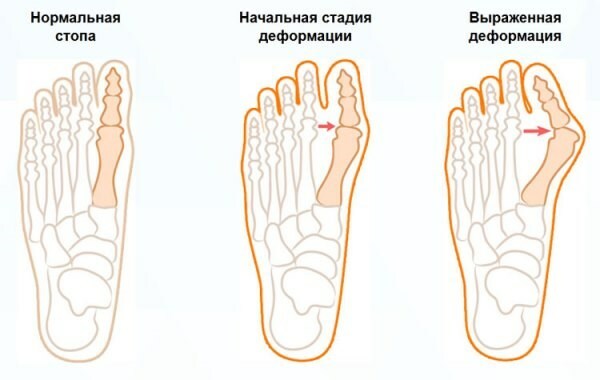
- shortening of the limb;
- the presence of clubfoot;
- scoliosis;
- dilated veins (varicose veins);
- diabetes;
- plantar fasciitis;
- musculoskeletal system injuries;
- during pregnancy.
The main properties of products include:
- vaults support;
- deformation protection;
- compensation for the lost functions of depreciation;
- optimization of the muscle tone of the feet;
- improved blood supply;
- ensuring walking comfort;
- elimination of pain.
Design and function of insoles with instep supports
The instep supports for the foot with flat feet, which are embedded in the shoes, have a certain relief. Thanks to their structure, the feet are supported in the correct anatomical position.
The instep supports are divided according to the degree of rigidity into 2 types:
- Models based on a rigid frame, which are intended for patients who have been on their feet for a long time. Such products are able to prevent subsidence of the vaults. Usually, insoles are used for the purpose of correcting deformations by inserting them into closed or sports shoes.
- Products based on a soft frame are most often used in women's shoes with high heels, during pregnancy and by athletes. The aim of the range is to prevent disease progression and to support vaults.
Orthopedic insoles can consist of zones:
- roll area;
- instep support is an element that supports the longitudinal arch;
- heel cavity;
- the metatarsal pad (pelot) is located in the area of the transverse arch - this is the rise in the roll zone;
- wedges under the heel.
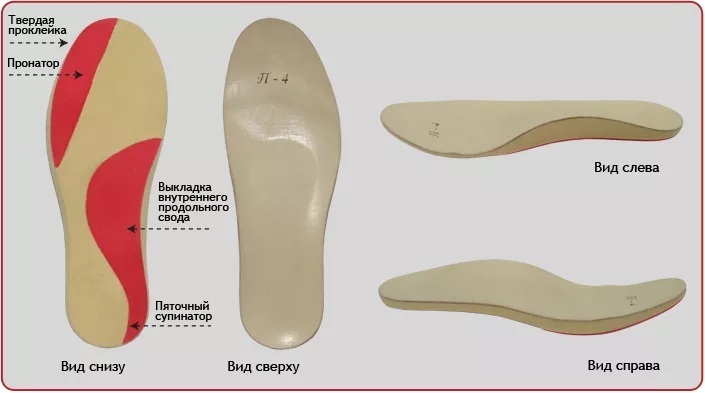
The main purpose of prescribing orthopedic devices is to ensure that the muscles, joints and bone tissues of the feet fulfill their functional tasks and protect against overstrain.
The functions of orthopedic products include:
- changes in the physiological structure of the foot;
- restoration of lost anatomical properties;
- correct load distribution;
- removing the load from the ankle and hip joints, as well as from the spine;
- providing amortization properties.
Therapeutic orthopedic devices should be made to order in accordance with the characteristics of the foot. In order to choose the right model, you need to make an appointment with a surgeon or orthopedist.
For longitudinal flat feet
With this pathology, the patient has a compaction of the longitudinal arch of the legs, due to which the foot completely begins to come into contact with the floor. The rate of manifestation and development of the disease is largely determined by the weight of a person: the higher it is, the more the pathology manifests itself.
The instep supports designed for longitudinal flat feet differ from other types by the presence of a high rise. The element performs the function of supporting the longitudinal arch, which contributes to the restoration of the physiological and anatomical structure of the legs.
As a result of wearing the products, you can achieve the following results:
- removing a heavy load from the legs;
- improving blood circulation;
- increasing the stability of the musculoskeletal system;
- elimination of pain syndrome;
- preventing the development or appearance of a heel spur.
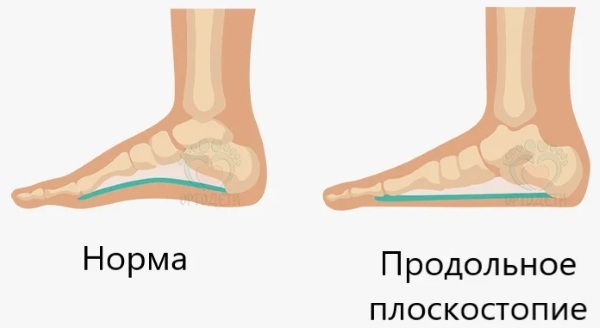
The structure of the model framework must include:
- wedges that optimize the angle of inclination of the arch;
- the height of the instep support, correctly selected in each individual case, determined by the structural features of the foot, the degree of the disease.
For transverse flat feet
The instep supports for the foot with flat feet are required to eliminate the seals of the transverse arches, which take vague shapes and are shortened with simultaneous retraction of the thumb to the side.
To correct the condition, it is necessary to wear insoles, which are characterized by the maintenance of the transverse arch, the presence of a pad. The element serves to evenly distribute weight on the forefoot area, the presence of a protective frame that supports the longitudinal arch.
If necessary, the design can be supplemented with a heel shock absorber, which reduces the load from impacts when walking. This, in turn, protects the Achilles tendon and hip joint from changes.
The instep support on such an insole model performs the functions of preventing the development of longitudinal flat feet.
For longitudinal-transverse flat feet
The combined type of flat feet is characterized by the process of spreading and compaction of both arches.
A number of symptoms of the disease include:
- rapid washing of shoes from the inside;
- the presence of pain in the lower extremities with prolonged standing or walking;
- observation of puffiness in the evening;
- Difficulty wearing high-heeled shoes
- an increase in the size range or the inability to wear model products;
- deformation of the fingers;
- the appearance of bones;
- the occurrence of pain in the legs and ankles;
- development of varicose veins;
- the presence of a blue tint of the skin of the legs.
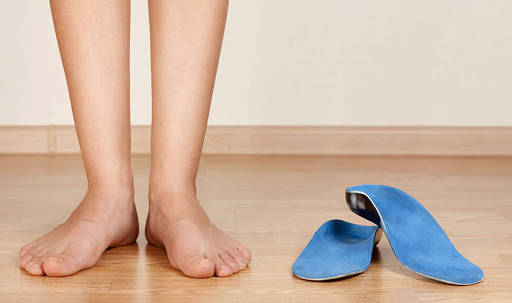
Insoles with longitudinal-transverse flat feet should provide the following functions:
- improving blood circulation;
- optimization of the load on the ligaments, muscles and joints of the lower extremities;
- reducing pain;
- relieving fatigue and puffiness;
- giving stability and smoothness to the gait;
- prevention of pathological changes in the feet.
The design of an orthopedic insole should include the following elements:
- instep support, selected individually;
- wedges under the heels;
- heel groove;
- metatarsal pad;
- the area of the roll with the rise.
Materials used, their properties and advantages
The instep support for the foot with flat feet should be made of wear-resistant materials that have the following properties:
- strength;
- depreciation;
- comfort.
Materials that come into contact with the skin must additionally have the following characteristics:
- hypoallergenic;
- breathability;
- hygroscopicity (the property of absorbing excess moisture);
- antibacteriality.
The materials for the manufacture of frames and insoles include:
- Genuine Leather;
- Cork;
- polyurethane foam;
- plastic;
- silicone, gel;
- fleece.
Gel, silicone
The frame for the instep support is often made of wear-resistant rubber that provides protection and support for the longitudinal arch, even distribution of the load over the foot.
Gel or silicone orthopedic insoles are characterized by the following properties:
- elasticity;
- softness;
- comfort;
- good shock absorption;
- uniform distribution of body load on the surface of the foot;
- weightlessness;
- plasticity;
- hygiene;
- durability.
Such products are suitable for sports and everyday wear, as well as for fashion shoes.
There are 2 types of gel:
- in a soft design that adapts to the individual characteristics of the foot;
- the solid look acts as a shock absorber.
Silicone is characterized by its homogeneous structure. The material adapts perfectly to the anatomical shape of the foot and is more suitable for everyday wear.
Individual elements of the insoles are often made from gel and silicone:
- instep supports;
- interdigital septa;
- protective parts on the bone;
- heel cushions;
- pelots.
Plastic
When making insoles for longitudinal flat feet, it is best suited from materials high temperature plastic that provides reliable and effective support for the arches, rigid fixation of the heels. The special thermoplastic material is characterized by good flexibility, which appears under the influence of temperature.
The advantages of making plastic insoles and insteps include:
- high manufacturing speed (about 30-40 minutes);
- the possibility of individual modeling of the forms of the arches of the foot to obtain a complete correction;
- providing an aesthetic advantage for the manufacture of individual insoles for model shoes with a heel height of up to 12 cm;
- high quality of products;
- affordable price;
- hygiene;
- comfort and convenience;
- antibacterial properties.
Genuine leather, fleece
Insoles for the treatment of transverse flat feet are most often made of genuine leather, which is characterized by the following properties:
- moisture absorption;
- absorption of odors;
- breathability;
- support the healthy state of the skin.
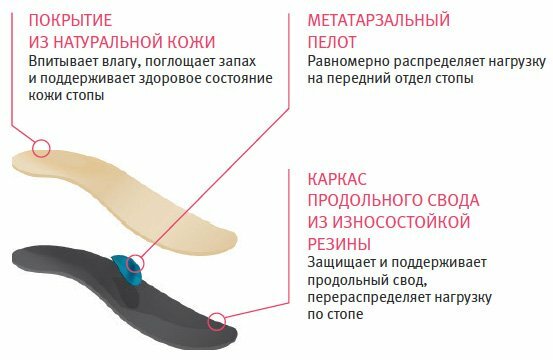
The classic materials for making insoles are leather, cotton, fleece. Such products are suitable for wearing in summer, autumn, spring, and winter.
Price range and best manufacturers
Flatfoot insteps can be found commercially in a variety of materials. The cost of orthopedic products depends on the manufacturer, purpose, quality.
The comparative characteristics of the models are summarized in the table:
| Pathology type | Manufacturer / product type | Manufacturing material | Appointment | Cost, rub. |
| Transverse flat feet | Trives / insoles | Latex foam, cotton. |
|
650-700 |
| Prevention of transverse flat feet | Braus / half insoles with instep support | Genuine leather, latex. |
|
500-580 |
| Combined flat feet | Sima-Land / half insoles with instep support, heel restraint and heel pad | Gel / silicone, fabric lining |
|
600-690 |
| Longitudinal flat feet | Corbby / insoles with instep support | Gel, fabric lining |
|
1200-1300 |
| Longitudinal flat feet | Pegasus / instep pad | Gel / silicone |
|
500-550 |
| Combined flat feet |
Alexander Geld / instep insoles |
Plastic, genuine leather |
|
1800-2000 |
How to choose the right instep support for the foot?
One of the main requirements when choosing products is the correspondence of the insole to the size of the shoe.
Experts recommend adhering to the following algorithm when choosing orthopedic products:
- It is necessary to decide on the purpose of wearing insoles (prevention or treatment).
- Further, according to your lifestyle, the degree of stiffness of the instep support and the material of its manufacture are selected.
- The selection of the type of product model should be carried out based on the needs of wearing. The full insole is suitable for closed types of shoes, the half insole is used with open sandals.
- The choice of coating material for the product is carried out from options: genuine leather, cotton, fleece, antibacterial coating. Here you should focus more on the season of wearing shoes.
Features of the selection for children
With flat feet in children, doctors prescribe insoles with instep supports for the feet. If you start treatment before the age of 12-14, then there is a high probability of getting rid of defects completely.
Parents, when choosing orthopedic insoles, should rely on the following criteria:
- Model parameters can only be determined by orthopedic surgeons or surgeons. You cannot choose insoles on your own, as their incorrect selection and wearing can cause additional harm.
- Regardless of the type of flat feet, products for children should have a thickened instep support, since the longitudinal vault in a child up to adolescence is in the formation and requires preventive support.
- In children's shoes, only full insoles should be selected, and not half insoles or instep support inserts.
Where to buy ready-made insoles with an instep support?
Orthopedic products can be purchased in specialized salons, pharmacies, stores that sell medical products.
Experts do not recommend buying orthopedic products in markets, in passages or places that are not intended for selling such products. When buying, you need to remember that incorrectly selected orthopedic devices can aggravate existing pathologies or develop new deformities.
In specialized retail outlets, all products are necessarily accompanied by quality certificates. Sellers must issue a warranty for the product when making a purchase. When choosing a place of purchase, it should be borne in mind that personal wear means can be adjusted several times during use.
How to make a do-it-yourself foot device?
You can independently make prophylactic liners at home that repeat the anatomical contour of the sole of the feet. Such products are designed to effectively distribute the load on the feet, as well as a shock absorber to cushion impacts when walking.
In order to make orthopedic insoles with an instep support, you must perform the following sequence of actions:
- It is necessary to remove the insoles from the old shoes.
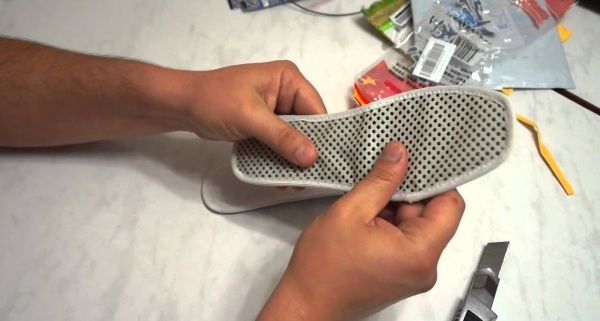
- Stand on the insole with bare feet and measure the points between the first and second toes. In this place, you need to stick a dense cotton ball with a diameter of 15 mm using a plaster.
- Next, you need to choose a comfortable foot lift using cotton wool or a bandage, which are placed under the longitudinal arch. Here you should focus on your feelings of convenience.
- The selected size of the instep support must be fixed to the insole.
- The resulting contour of the insole must be transferred to a material with good ventilation and moisture absorption properties (cotton, leather, fleece). Then the workpiece is cut out and glued over the old insole so that the rollers under the toes and under the arch are covered.
- In order for the upper part of the workpiece to hold well, it can be sewn along the contour by hand or on a typewriter.
- The finished liner must be inserted into the shoe and checked for comfort.
- Then steps from 2 to 7 should be repeated to make the liner for the other foot.
Wearing rules
In order for the product to provide the necessary therapeutic or prophylactic effect, you must follow the following rules of wearing:
- Products with a rigid frame should be worn 3-4 hours daily until the legs get used to the correction effect.
- Do not use the devices during active sports or training during the first week of wearing.
- Models made of foam latex (gel, silicone) or plastic can be worn initially throughout the day, as legs quickly get used to such products.
- When using models intended for sports with plastic frames, it is necessary to start using them for a short period with a gradual increase in the load.
- Individual earbuds are the hardest to get used to, but they have the greatest therapeutic effect. Their use should be started shortly.
- In the case when, after 1-1.5 weeks after the start of wearing the products, a person continues to experience discomfort and there is no addiction, then it is necessary to replace or correct such insoles master.
Care
The list of features for caring for insoles with an instep support includes:
- Use a soft brush or cloth to clean the cover.
- Leather products can be wiped with a mild alcohol solution.
- Other materials (silicone, gel, plastic) can be cleaned with a concentrated soap solution.
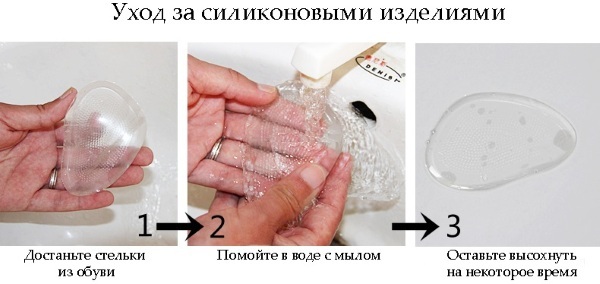
Care of the instep supports for the foot with flat feet - Do not wash insoles under running water or in a washing machine.
- It is forbidden to use agents with aggressive detergents when cleaning.
- When shoes with insoles get wet and rain, don't be upset, as manufacturers often use waterproof materials in their production. After contact with water, the product must be dried in natural conditions away from heating appliances and sunlight.
- When wearing shoes with insoles, they must be removed and ventilated daily.
At home, you can make do-it-yourself insoles with an instep support for the foot of a preventive nature. If there is a goal of eliminating flat feet defects, then it will not be possible to do without consulting surgeons or orthopedists.
Video about orthopedic insoles
About orthopedic insoles. Harm and benefit:
